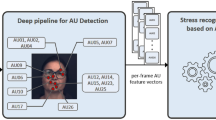Abstract
Stress is a major problem that infiltrates our society in countless ways. We cannot eliminate stress, but can recognize stress and manage it. Automatically recognizing stress through facial expressions has been extensively studied in the past decades. Recent research indicates that certain architectures can reach state-of-the-art accuracy in stress recognition. However, they recognise facial stress in view of static expressions, while only a few papers identify the fundamental limitations of static facial expression. This paper adapts ANUStressDB database in dynamic and develops a Temporal Convolutional Network to recognize continuous facial stress problem. We further apply Bimodal Distribution Removal to improve our result. The experimental results show that our system achieves 67.56% classification accuracy.
Access this chapter
Tax calculation will be finalised at checkout
Purchases are for personal use only
Similar content being viewed by others
References
Alfons, A., Croux, C., Gelper, S.: Sparse least trimmed squares regression for analyzing high-dimensional large data sets. Ann. Appl. Stat. 7(1), 226–248 (2013)
Andreassi, J.L.: Psychophysiology : Human Behavior and Physiological Response. Oxford University Press, New York (1980)
Bai, S., Kolter, J.Z., Koltun, V.: An empirical evaluation of generic convolutional and recurrent networks for sequence modeling. arXiv:1803.01271 (2018)
Caruana, R., Lawrence, S., Giles, C.L.: Overfitting in neural nets: backpropagation, conjugate gradient, and early stopping. In: Advances in Neural Information Processing Systems, pp. 402–408 (2001)
Cho, K., et al.: Learning phrase representations using RNN encoder-decoder for statistical machine translation. arXiv preprint arXiv:1406.1078 (2014)
Cowan, R.: High technology and the economics of standardization (1992)
Gen, M., Lin, L.: Genetic Algorithms. Wiley Encyclopedia of Computer Science and Engineering, pp. 1–15 (2007)
Goodfellow, I., Bengio, Y., Courville, A.: Deep Learning. MIT Press, Cambridge (2016)
Hochreiter, S., Schmidhuber, J.: Long short-term memory. Neural Comput. 9(8), 1735–1780 (1997)
Irani, R., Nasrollahi, K., Dhall, A., Moeslund, T.B., Gedeon, T.: Thermal super-pixels for bimodal stress recognition. In: IPTA, pp. 1–6. IEEE (2016)
Li, Z., Chen, J.: Superpixel segmentation using linear spectral clustering. In: Proceedings of the IEEE Conference on Computer Vision and Pattern Recognition, pp. 1356–1363 (2015)
Long, J., Shelhamer, E., Darrell, T.: Fully convolutional networks for semantic segmentation. In: Proceedings of the IEEE Conference on Computer Vision and Pattern Recognition, pp. 3431–3440 (2015)
Oord, A.V.D., et al.: WaveNet: a generative model for raw audio. arXiv:1609.03499 (2016)
Pietikäinen, M., Hadid, A., Zhao, G., Ahonen, T.: Local binary patterns for still images. In: Computer Vision Using Local Binary Patterns, pp. 13–47. Springer (2011). https://doi.org/10.1007/978-0-85729-748-8_2
Prasetio, B.H., Tamura, H., Tanno, K.: The facial stress recognition based on multi-histogram features and convolutional neural network. In: 2018 IEEE International Conference on Systems, Man, and Cybernetics (SMC), pp. 881–887. IEEE (2018)
Rousseeuw, P.J.: Least median of squares regression. J. Am. Stat. Assoc. 79(388), 871–880 (1984)
Sankaradas, M., et al.: A massively parallel coprocessor for convolutional neural networks. In: 2009 20th IEEE International Conference on Application-Specific Systems, Architectures and Processors, pp. 53–60. IEEE (2009)
Schneiderman, N., Ironson, G., Siegel, S.D.: Stress and health: psychological, behavioral, and biological determinants. Annu. Rev. Clin. Psychol. 1(1), 607–628 (2005)
Sharma, N., Dhall, A., Gedeon, T., Goecke, R.: Thermal spatio-temporal data for stress recognition. EURASIP J. Image Video Process. 2014(1), 28 (2014)
Slade, P., Gedeon, T.D.: Bimodal distribution removal. In: Mira, J., Cabestany, J., Prieto, A. (eds.) IWANN 1993. LNCS, vol. 686, pp. 249–254. Springer, Heidelberg (1993). https://doi.org/10.1007/3-540-56798-4_155
Wójcik, P.I., Kurdziel, M.: Training neural networks on high-dimensional data using random projection. Pattern Anal. Appl. 22(3), 1221–1231 (2019)
Yu, F., Koltun, V.: Multi-scale context aggregation by dilated convolutions. arXiv preprint arXiv:1511.07122 (2015)
Author information
Authors and Affiliations
Corresponding author
Editor information
Editors and Affiliations
Rights and permissions
Copyright information
© 2019 Springer Nature Switzerland AG
About this paper
Cite this paper
Feng, S. (2019). Dynamic Facial Stress Recognition in Temporal Convolutional Network. In: Gedeon, T., Wong, K., Lee, M. (eds) Neural Information Processing. ICONIP 2019. Communications in Computer and Information Science, vol 1142. Springer, Cham. https://doi.org/10.1007/978-3-030-36808-1_76
Download citation
DOI: https://doi.org/10.1007/978-3-030-36808-1_76
Published:
Publisher Name: Springer, Cham
Print ISBN: 978-3-030-36807-4
Online ISBN: 978-3-030-36808-1
eBook Packages: Computer ScienceComputer Science (R0)




